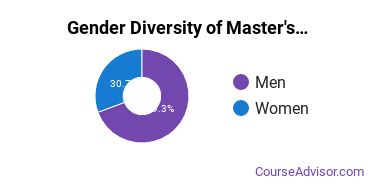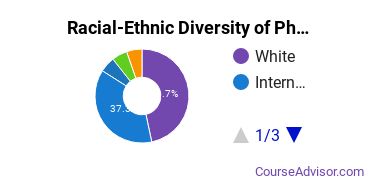Master’s Degrees in General Physical Sciences
Featured schools near , edit
Education Levels of Physical Science Majors
In 2020-2021, 75 master's degrees were awarded to physical science majors. This earns it the #250 spot on the list of the most popular master's degree programs in the nation.
The following table shows the number of diplomas awarded in physical science at each degree level.
| Education Level | Number of Grads |
|---|---|
| Associate Degree | 3,395 |
| Bachelor’s Degree | 320 |
| Master’s Degree | 75 |
| Doctor’s Degree | 32 |
| Undergraduate Certificate | 1 |
Earnings of Physical Science Majors With Master’s Degrees
At this time, we do not have the data to estimate the median earnings for this class of people.
Student Debt
We do not have the data to calculate the median and range of debt loads for physical science students who are master's degree holders.
Student Diversity
More men than women pursue master's degrees in physical science. About 69.3% of graduates in this field are male.
| Gender | Number of Grads |
|---|---|
| Men | 52 |
| Women | 23 |

The racial-ethnic distribution of physical science master’s degree students is as follows:
| Race/Ethnicity | Number of Grads |
|---|---|
| Asian | 0 |
| Black or African American | 4 |
| Hispanic or Latino | 4 |
| White | 35 |
| International Students | 28 |
| Other Races/Ethnicities | 4 |

Most Popular Physical Science Programs for Master’s Degrees
There are 13 colleges that offer a master’s degree in physical science. Learn more about the most popular 13 below:
University of Chicago tops the list of the most popular school in the U.S. for physical science majors who are seeking their master's degree. Each year, around 17,800 students seeking various degrees attend the university. The average in-state tuition for full-time undergraduates is $59,256 per year, while in-state graduate students, on average, pay $62,640 per year. The physical science program at University of Chicago awarded 24 master's degrees during the 2020-2021 school year. About 38% of this group were women, and 25% were students from an underrepresented racial-ethnic group.
The 2nd most popular school in the country for physical science majors who are seeking their master's degree is Naval Postgraduate School. Roughly 2,800 attend the school each year. The physical science program at Naval Postgraduate School awarded 13 master's degrees during the 2020-2021 school year. Around 15% of these students were from an underrepresented racial-ethnic group, and 31% were women.
Yale University comes in at #3 on our list of the most popular colleges offering master's degrees in physical science. The average in-state tuition for full-time undergraduates is $59,950 per year, while in-state graduate students, on average, pay $45,700 per year. The physical science program at Yale University awarded 10 master's degrees during the 2020-2021 school year.
The 4th most popular school in the country for physical science majors who are seeking their master's degree is Rochester Institute of Technology. Each year, around 16,100 students seeking various degrees attend the university. The average in-state tuition for full-time undergraduates is $50,225 per year, while in-state graduate students, on average, pay $52,092 per year. The physical science program at Rochester Institute of Technology awarded 9 master's degrees during the 2020-2021 school year.
The 5th most popular school in the country for physical science majors who are seeking their master's degree is Georgia Southern University. Each year, around 26,900 students seeking various degrees attend the university. The average in-state tuition for full-time undergraduates is $4,371 per year, while in-state graduate students, on average, pay $4,986 per year. For the 2020-2021 academic year, 7 master's degrees were handed out to physical science majors at GaSou. Of these students, 29% were women and 29% were members of underrepresented racial-ethnic groups.
University of Arkansas at Little Rock is the 6th most popular school in the nation for students seeking a master's degree in physical science. Each year, around 8,800 students seeking various degrees attend the university. The average in-state tuition for full-time undergraduates is $6,495 per year, while in-state graduate students, on average, pay $5,760 per year. During the 2020-2021 academic year, 5 people received their master's degree in physical science from UA Little Rock.
Wesleyan University is the 7th most popular school in the nation for students seeking a master's degree in physical science. Roughly 3,000 attend the school each year. The average in-state tuition for full-time undergraduates is $61,449 per year, while in-state graduate students, on average, pay $61,449 per year. The physical science program at Wesleyan University awarded 3 master's degrees during the 2020-2021 school year.
Emporia State University comes in at #8 on our list of the most popular colleges offering master's degrees in physical science. The average in-state tuition for full-time undergraduates is $5,278 per year, while in-state graduate students, on average, pay $6,547 per year. The physical science program at Emporia State University awarded 2 master's degrees during the 2020-2021 school year.
The 8th most popular school in the country for physical science majors who are seeking their master's degree is Marshall University. Each year, around 11,900 students seeking various degrees attend the university. The average in-state tuition for full-time undergraduates is $7,190 per year, while in-state graduate students, on average, pay $7,520 per year. For the 2020-2021 academic year, 2 master's degrees were handed out to physical science majors at Marshall University.
Explore Major by State
Alabama
Arkansas
Connecticut
Florida
Idaho
Iowa
Louisiana
Massachusetts
Mississippi
Nebraska
New Jersey
North Carolina
Oklahoma
Rhode Island
Tennessee
Vermont
West Virginia
Related Majors
Below are some popular majors that are similar to physical science that offer master’s degrees.
| Major | Annual Degrees Awarded |
|---|---|
| Chemistry | 2,246 |
| Physics | 1,949 |
| Geological & Earth Sciences | 1,663 |
| Materials Sciences | 270 |
| Atmospheric Sciences | 213 |
References
*The racial-ethnic minority student count is calculated by taking the total number of students and subtracting white students, international students, and students whose race/ethnicity was unknown. This number is then divided by the total number of students at the school to obtain the percentage of racial-ethnic minorities.
More about our data sources and methodologies.
Featured Schools
 Request Info
Request Info
|
Southern New Hampshire University You have goals. Southern New Hampshire University can help you get there. Whether you need a bachelor's degree to get into a career or want a master's degree to move up in your current career, SNHU has an online program for you. Find your degree from over 200 online programs. Learn More > |







